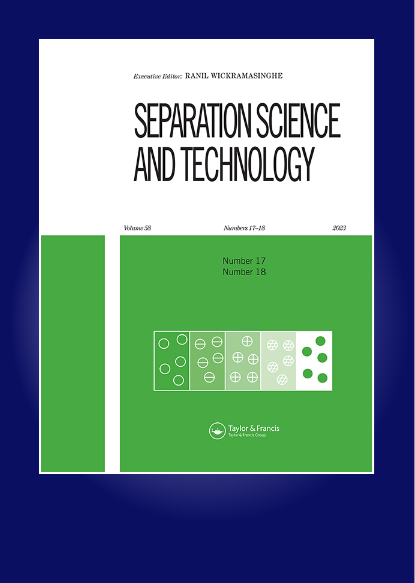Investigating the effects of sacrificial agents on MO dye degradation with Ag2Se nanocomposites via chemical wet method using visible light irradiation
IF 2.3
4区 工程技术
Q3 CHEMISTRY, MULTIDISCIPLINARY
引用次数: 0
Abstract
ABSTRACT In this study, the degradation of MO (Methyl orange) dye using visible light irradiation and Ag2Se photo-catalyst was investigated. The Ag2Se photo-catalyst was synthesized via a wet chemical technique and characterized by using X-ray diffraction (XRD) for structural analysis, scanning electron microscopy (SEM) for surface morphology, transmission electron microscopy (TEM) for inner structure, Raman and UV-Vis spectroscopy for the study of its optical properties. The results showed that the Ag2Se photo-catalyst has a well-defined cubic crystal structure with a typical particle size of 50 to 76.5 nm. The UV-Vis absorption spectrum of the Ag2Se photo-catalyst revealed a strong absorption in the visible light region, indicating its potential as visible light photo-catalyst. The photocatalytic degradation of MO dye was carried out under visible light irradiation using the synthesized Ag2Se photo-catalyst. The results showed that the degradation efficiency of MO dye reached 95% after 150 min of irradiation. The degradation of MO dye was attributed to the generation of reactive oxygen species (ROS) and the formation of Ag nanoclusters on the surface of the Ag2Se photo-catalyst. The stability of the Ag2Se photo-catalyst was also examined, and the results exhibited that the photo-catalyst was stable and could be reused for subsequent photocatalytic degradation experiments. The Ag2Se photo-catalyst showed an outstanding photo catalytic activity for the degradation of MO dye underneath visible light irradiation. The study proposes that the Ag2Se photo-catalyst can be used for the treatment of wastewater containing organic pollutants.可见光下化学湿法研究牺牲剂对Ag2Se纳米复合材料降解MO染料的影响
摘要本研究研究了可见光照射下Ag2Se光催化剂对MO(甲基橙)染料的降解。采用湿化学法合成Ag2Se光催化剂,并利用x射线衍射(XRD)进行结构分析,扫描电镜(SEM)进行表面形貌分析,透射电镜(TEM)进行内部结构分析,拉曼光谱(Raman)和紫外可见光谱(UV-Vis)研究其光学性质。结果表明,Ag2Se光催化剂具有良好的立方晶体结构,典型粒径为50 ~ 76.5 nm;Ag2Se光催化剂的紫外-可见吸收光谱显示其在可见光区有较强的吸收,表明其作为可见光光催化剂的潜力。采用合成的Ag2Se光催化剂,在可见光照射下对MO染料进行了光催化降解。结果表明,辐照150 min后,MO染料的降解效率达到95%。MO染料的降解归因于活性氧(ROS)的产生和Ag2Se光催化剂表面银纳米团簇的形成。结果表明,所制备的Ag2Se光催化剂性能稳定,可用于后续的光催化降解实验。Ag2Se光催化剂在可见光下对MO染料的降解表现出优异的光催化活性。研究表明,Ag2Se光催化剂可用于处理含有机污染物的废水。
本文章由计算机程序翻译,如有差异,请以英文原文为准。
求助全文
约1分钟内获得全文
求助全文
来源期刊

Separation Science and Technology
工程技术-工程:化工
CiteScore
6.10
自引率
3.60%
发文量
131
审稿时长
5.7 months
期刊介绍:
This international journal deals with fundamental and applied aspects of separation processes related to a number of fields. A wide range of topics are covered in the journal including adsorption, membranes, extraction, distillation, absorption, centrifugation, crystallization, precipitation, reactive separations, hybrid processes, continuous separations, carbon capture, flocculation and magnetic separations. The journal focuses on state of the art preparative separations and theoretical contributions to the field of separation science. Applications include environmental, energy, water, and biotechnology. The journal does not publish analytical separation papers unless they contain new fundamental contributions to the field of separation science.
 求助内容:
求助内容: 应助结果提醒方式:
应助结果提醒方式:


